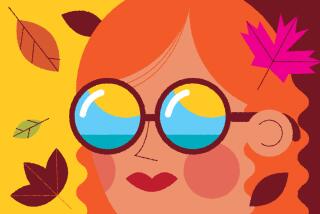Falling for Autumn : Seeds of Change Begin in a Landscape of Colors and Textures
- Share via
If you’re one of those Southern California gardeners who misses the change of seasons found in other areas of the country, reconsider your evergreen landscape and plant a fall garden that announces the coming of cooler months.
When the landscape is all evergreen and unchanging, Orange County gardeners get bored, said Ron Vanderhoff, manager of Flowerdale Nurseries in Santa Ana and Costa Mesa.
“By interspersing your yard with plants that strike a note of fall and winter, you create a dynamic, changing landscape with different tones, textures and shapes that invites you to go out and explore it,” he said.
There are many deciduous trees, such as the liquidambar, that will produce a fall color display in our mild climate. When allowed to go to seed, other plants display interesting seed heads and pods, sometimes more beautiful than their original flowers.
The Mickey Mouse plant (Ochna serrulata) has unremarkable early summer flowers. But when the flowers fall off and the sepals turn vivid red, they fill with seed-like fruit that eventually become a glossy jet black. That’s when the plant catches a lot of attention.
Many plants have a festive berry display in the fall and winter, such as pyracantha or firethorn, which has a wide variety of berry colors to choose from, and the California pepper tree, which is covered in sprays of rosy-red pepper berries that hang on through winter and attract birds.
Many gardeners also appreciate trees that have attractive bark or whose branches, when bare, can resemble stunning aerial sculptures.
The crape myrtle (Lagerstroemia indica) has smooth, textured bark that gets striking blotches of brown, rust and orange, especially after rain and a little sunshine.
Although many Southlanders avoid deciduous plants, those are usually the plants that give a feeling of seasonal change, Vanderhoff said.
“Deciduous plants aren’t as labor-intensive as they might seem,” he said. In many ways, they’re easier than evergreens, because they only lose their leaves once a year, whereas evergreens can lose leaves all year long.
Near a ficus, plant a ginkgo tree, which produces a profusion of golden yellow leaves that linger--until they drop all at once.
Or next to your juniper, you can plant a Chinese flame tree (Koelreuteria bipinnata ). This has leaves that turn yellow for a short time before dropping. The plant’s showy, two-inch seed capsules hang in clusters of orange, red and salmon.
Most seed heads and pods last through autumn and some on into winter, although they will succumb to rough weather, especially Santa Ana winds and hard rain. Although leaves tend to change color and drop by the end of autumn, many berries hang on to plants throughout our climate’s mild winters. Textural bark often looks even better in rainy, cool weather.
The best benefit about this type of fall garden is that very little maintenance is required. If you’ve taken good care of the plants in spring and summer, they should produce ample seed and fruit in the fall, said Laguna Beach landscape architect Ann Christoph.
If you do light pruning in the garden, be careful not to remove any seed heads you wish to keep, because they won’t grow back. Also be careful not to knock off seed pods and capsules.
For a real fall garden show, put away your pruning sheers and just watch, Vanderhoff suggested.
“Let the plants grow in their natural manner, rather than doing a lot of formal clipping and tidying, and you’ll probably see something different,” he said.
Adjust your watering schedule. Water requirements drop considerably in the fall and winter, so don’t over-water.
No matter what your garden design, there is something with fall interest that will fit into your landscape, said landscape designer Jeff Garton, co-owner of Paradise Designs Inc. in Dana Point.
When planning a landscape with plants that have seed heads or pods or interesting stem structures, consider their placement. Set such plants against a clean background such as a bare wall rather than in front of a busy landscape, where they can get lost.
Also consider lighting, both day and night. Ornamental grasses and leafy or lacy trees, for instance, look best with back lighting that accents them as they move in the wind.
Plants with unusual seed heads or sculptural branching look best with front lighting, which creates interesting shadows on a plain background.
Ornamental bark is best seen up close, so plant at eye level, and near windows, if possible, for a full effect, Garton said.
You can also set some of these plants off by placing them among evergreens.
With this type of garden, Garton cautioned: “Realize that the plants you let go to seed may reseed in other areas of your yard and that some of these plants have pollen, which may be a problem for allergy sufferers.”
When it comes to a more natural garden, a gardener has to have tolerance, Vanderhoff said.
“There will be some leaf drop and seed scattering,” he said. “But it’s all a part of winter and fall. Why not go out and rake up the leaves and enjoy the change of seasons your yard has to offer?”






